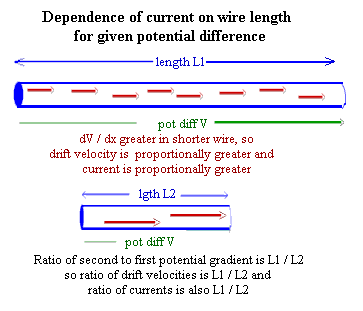
Problem: What force is experienced by an electron (charge 1.6 x 10^-19 Coulomb) in the electric field created by a 6-volt battery (assume negligible internal resistance) in a uniform conducting wire 4.4 meters long?
.
.
.
.
.
.
.
.
.
.
.
.
.
.
.
.
.
.
.
.
.
.
.
.
.
.
.
.
.
.
Solution: From the charge (Coulombs) and voltage (Joules / Coulomb) we can find the amount of work done. Then from the work and distance we can easily find the force.
We know that the work done is 6 J/C (1.6 x 10^-19 C) = 9.6 x 10^-19 J = 9.6 x 10^-19 N m.
If 9.6 x 10^-19 N m of work are done by a uniform force over a distance of 4.4 meters, the force is 9.6 x 10^-19 N m / ( 4.4 m) = 2.181 + 10^-19 N.
Generalized Response: The work done on charge q through potential difference `dV is `dW = q `dV. If this work is done over distance `dx, then we see that the average force exerted on q is Fave = `dW / `dx = q `dV / `dx. The quantity `dV / `dx is the average potential gradient, also called the average electric field, over the path followed by the charge. Note that the force on the charge is always in the direction of the wire, as is the distance `dx.
.
.
.
.
.
.
.
.
.
.
Figure description: The figure below shows two wires of different lengths with the same potential difference V between their ends. The potential gradient E = dV / dx is greater in the shorter wire, so the drift velocity is higher. The higher drift velocity implies a proportionally higher current.